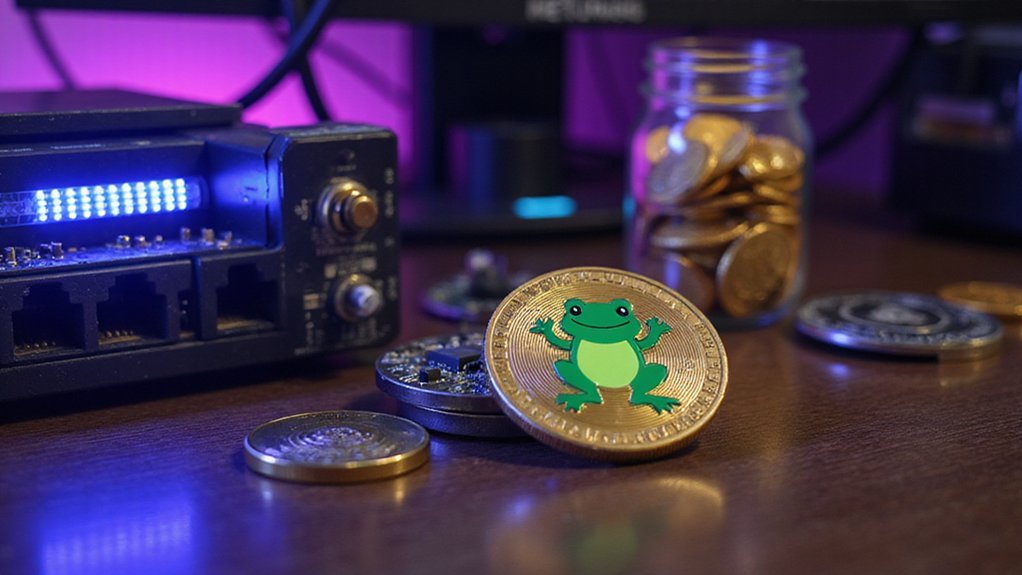Crypto assets encompass diverse digital instruments—from Bitcoin’s peer-to-peer currency model to NFTs representing unique ownership rights—that operate through blockchain networks independently of traditional market structures. These tamper-proof distributed ledgers eliminate intermediaries while creating notorious volatility (Bitcoin’s 22% daily swings terrify institutional investors). Regulatory frameworks struggle with jurisdictional patchworks as assets evolve from speculative memes to legitimate investment vehicles, though exchange hacks and market manipulation remain persistent concerns for those venturing deeper into this decentralized ecosystem.

The digital world has spawned a peculiar breed of assets that exist solely as strings of code yet command trillion-dollar markets—crypto assets, those blockchain-secured digital instruments that have somehow convinced both venture capitalists and your neighbor’s college-aged son that the future of finance lies in decentralized networks rather than marble-columned institutions.
Digital code masquerading as legitimate assets has somehow persuaded both Wall Street titans and college dormitory day-traders alike.
These cryptographically secured assets operate independently of central banks, relying instead on distributed ledger technology to maintain transaction integrity. The taxonomy includes cryptocurrencies like Bitcoin (serving as digital currency), non-fungible tokens representing unique ownership rights, security tokens mimicking traditional equity structures, and utility tokens providing access to specific goods or services. Each category functions within peer-to-peer networks that eliminate intermediaries—a feature that either represents revolutionary democratization or systematic elimination of financial oversight, depending on one’s regulatory disposition.
Blockchain technology undergirds this entire ecosystem, creating tamper-proof public ledgers where every transaction receives cryptographic verification. The irony is palpable: assets designed to exist without traditional financial infrastructure now require institutional investment for legitimacy, with major corporations and pension funds allocating portions of portfolios to these supposedly anti-establishment instruments.
Market volatility remains crypto assets‘ defining characteristic, producing price swings that would make commodity traders seasick. This volatility simultaneously attracts speculators seeking outsized returns and terrifies institutional investors accustomed to predictable risk-return profiles. Bitcoin’s value has demonstrated this extreme unpredictability by changing up to 22% in one day, showcasing the dramatic fluctuations that define the crypto market. The decentralized governance models embedded in many crypto assets theoretically democratize financial decision-making, though whether “governance by internet consensus” represents progress or chaos remains hotly debated.
Regulatory frameworks struggle to keep pace with innovation, creating jurisdictional patchworks where crypto assets exist in legal limbo. Some countries embrace them as legitimate investment vehicles or even legal tender, while others ban them outright. Taxation authorities, never ones to miss revenue opportunities, increasingly treat crypto assets as capital assets subject to gains taxes.
Despite security measures inherent in blockchain technology, crypto assets face risks ranging from exchange hacks to regulatory crackdowns. Consumer protection remains minimal in many jurisdictions, leaving investors vulnerable to fraud and market manipulation. Yet institutional adoption continues accelerating, suggesting that regardless of skepticism, crypto assets have secured their position in modern financial portfolios—whether that position proves prescient or disastrous remains history’s judgment. The evolution from meme to currency exemplifies how internet culture can unexpectedly generate legitimate financial instruments, as demonstrated by certain cryptocurrencies that began as jokes but developed substantial market value and dedicated communities. Notably, cryptocurrencies derive their value not from any underlying asset but through perceived value determined entirely by market supply and demand dynamics.
Frequently Asked Questions
How Do I Calculate Taxes on Crypto Asset Gains and Losses?
One calculates crypto taxes by determining cost basis (original purchase price) and subtracting it from disposal proceeds for each transaction—whether selling, trading, or spending digital assets.
The resulting gains face ordinary income rates if held under one year, or preferential capital gains rates beyond that threshold.
Losses offset gains dollar-for-dollar, with excess losses (up to $3,000 annually) reducing ordinary income, because tax code complexity apparently needed cryptocurrency’s assistance.
What Happens to My Crypto if the Exchange Gets Hacked?
When exchanges suffer breaches, crypto holdings face immediate theft risk—as demonstrated by Bybit’s staggering $1.5 billion Ethereum loss.
Assets typically vanish into laundering networks within hours, making recovery exceptionally difficult given cryptocurrency’s pseudonymous nature.
While some exchanges offer compensation (though guarantees remain elusive), users bear primary responsibility for protection through cold storage diversification and hardware wallets—because apparently trusting centralized entities with decentralized assets presents certain inherent contradictions.
Can I Use Crypto Assets as Collateral for Traditional Loans?
Crypto assets can serve as collateral for traditional loans, though the arrangement requires handling a patchwork of state regulations—over 25 jurisdictions have adopted 2022 UCC amendments clarifying legal frameworks.
Borrowers face daily margin calls due to volatility, with loan-to-value ratios demanding constant monitoring.
Unlike traditional assets, crypto’s decentralized nature complicates enforcement, while regulatory uncertainty leaves lenders wary of structures that blend blockchain transparency with conventional credit risk management.
How Do Crypto Market Hours Differ From Stock Market Trading Hours?
Cryptocurrency markets operate continuously—a perpetual financial carnival that never closes—while traditional stock exchanges maintain civilized business hours (typically 9:30 AM to 4 PM ET for major U.S. markets).
This fundamental difference means crypto traders can witness their portfolios experience dramatic swings at 3 AM on Sunday, whereas stock investors enjoy the luxury of predictable dormancy outside trading sessions.
The decentralized nature of blockchain enables this 24/7 accessibility.
What’s the Minimum Investment Required to Start Trading Crypto Assets?
Cryptocurrency exchanges have democratized market entry with remarkably low barriers—investors can commence trading with merely $10 on platforms like Kraken or Binance.
Unlike traditional securities requiring full-share purchases, fractional cryptocurrency ownership enables diversification across multiple assets with minimal capital.
While conventional investment minimums often reach hundreds or thousands, crypto’s accessibility (perhaps ironically) allows beginners to enter volatile markets with pocket change, though this ease shouldn’t obscure inherent risks.









